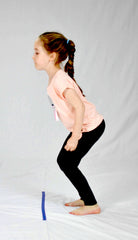5 ways educators can improve children's motor skills with just a piece of paper and masking tape
Children's motor development doesn't require fancy equipment or expensive resources.
Here are 5 activities that you can implement into your day to improve children's motor skill development with just a piece of paper and masking tape.
1 - Let's Jump
Children should be able to jump with both feet at the same time on the spot at the age of 3 years. Children should be able to jump with both feet in a forward direction (like this photo) at the age of 4 years. However, I see a large number of children aged 5 years struggling with this gross motor skill.
Jumping uses the part of the brain called the cerebellum. This part of the brain is responsible for our gross motor skill of balance, as well as focus, concentration, and attention. As a result, children who typically find it difficult to jump and
balance, may also find it hard to focus and may be easily distracted in the classroom because their cerebellum is underdeveloped.
So learning to jump on the spot and jump forward is one of the crucial skills needed for the development of children’s development and learning.
 ACTIVITY
ACTIVITY
2 - Spin and throw
In order for you to be able to read these words right now, without skipping words, getting a headache, seeing letters in reverse, you firstly need to have the ability to:
 ACTIVITY
ACTIVITY
3 - Trace ball along line
Children are currently showing lower ball skills than previous generations. While we don't need all children to be elite athletes, we would like our children to grow up being confident with their movement, so that when our children are teenagers they are living an active lifestyle, running around and playing with their peers, rather than sitting sedentary.
Physical activity confidence starts with being able to build up fundamental movement skills such as throwing and catching a ball, jumping, hopping, skipping, etc.
We need basic gross motor skills to develop fundamental movement skills such as reaching, grasping, bilateral coordination, core strength, crossing the midline, visual tracking, spatial awareness, etc.
 ACTIVITY
ACTIVITY
4 - Tunnel ball
Tunnel ball is a fun activity that encourages important gross motor skills including: core strength, vestibular balance and balance.
More importantly tunnel ball is usually a group activity which teaches children about the importance of working cooperatively with others, waiting their turn, standing patiently in line. These social skills are just as important as the motor skills involved in this activity.
5 - Tear paper
Tearing paper is one of the most important fine motor skill activities to learn. Tearing paper using the first two fingers and thumb encourages the last two fingers (ring finger and little finger) to relax. This progresses a child's fine motor skills from a full grasp position (toddler) to a pincer grip position (preschooler).
When observing children tear paper, make sure that children aren't:
- Using their shoulders and elbows to try and tear the paper
- Using all of their 5 fingers on each hand to try and tear the paper
Instead, encourage children to:
- Keep their ring finger and little finger tucked away from the paper, so their first two fingers and thumb tear the paper
- Tuck their elbows in towards their ribs, rather than having their elbows out away from the body
 ACTIVITY
ACTIVITY
Provide children with a piece of paper to tear into 6 long strips, then tear each of the 6 strips into 20 small squares. By giving children a number of strips and square to aim for, we will reduce the possibility of children rushing through the activity.
Once you have 120 squares of paper either do a mosaic piece of art, pretend to feed the toy dinosaurs, or create fairy garden stepping stones with the paper.
PS. If you love this content, you will love my free gross motor skills resource package
For more activity ideas order my Early Childhood Movement Program book










I would like to have this book to help my learner’s. Thanks
Leave a comment